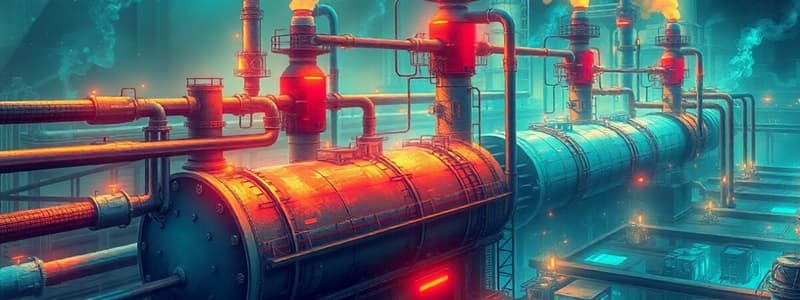Podcast
Questions and Answers
What is the primary purpose of the Stabilization Section in scrubbers?
What is the primary purpose of the Stabilization Section in scrubbers?
To deactivate aluminum alkyls and reduce clogging in downstream equipment.
What is the goal for paraffin content in the alpha olefin product after stabilization?
What is the goal for paraffin content in the alpha olefin product after stabilization?
To reduce the paraffin content to 0.2% or less.
How does the Saturate Reduction System contribute to the alpha olefin product?
How does the Saturate Reduction System contribute to the alpha olefin product?
It reduces the paraffin content in the product.
What are the main components separated in D-310A/B (Reactor Effluent Separators)?
What are the main components separated in D-310A/B (Reactor Effluent Separators)?
What happens to the overhead vapor from the TEA Scrubber (T-330)?
What happens to the overhead vapor from the TEA Scrubber (T-330)?
What is the role of the nickel catalyst in the process?
What is the role of the nickel catalyst in the process?
What is the purpose of E-426 (C8 Tower Bottoms Cooler) in the scrubber process?
What is the purpose of E-426 (C8 Tower Bottoms Cooler) in the scrubber process?
What type of stream is primarily recycled back into the Ethylene Feed Section?
What type of stream is primarily recycled back into the Ethylene Feed Section?
How is the liquid product heated before reaching the Static Mixer?
How is the liquid product heated before reaching the Static Mixer?
What downstream issue is prevented by removing aluminum alkyls in the scrubber?
What downstream issue is prevented by removing aluminum alkyls in the scrubber?
What is the purpose of E-321 in the process flow?
What is the purpose of E-321 in the process flow?
How is the nickel concentration in D-321 reduced?
How is the nickel concentration in D-321 reduced?
What role do P-321A/B serve in the process?
What role do P-321A/B serve in the process?
Why does D-322 need to be refilled after each blend from D-321?
Why does D-322 need to be refilled after each blend from D-321?
What is the purpose of the nitrogen blanket in D-321 and D-322?
What is the purpose of the nitrogen blanket in D-321 and D-322?
What happens to the NAO product after cooling in E-321?
What happens to the NAO product after cooling in E-321?
What type of catalyst is being used in D-321 and D-322?
What type of catalyst is being used in D-321 and D-322?
In what form is the nickel catalyst received from the supplier?
In what form is the nickel catalyst received from the supplier?
What equipment is used to mix the nickel catalyst in D-321?
What equipment is used to mix the nickel catalyst in D-321?
What is the significance of routing the 0.2% nickel catalyst into the process stream?
What is the significance of routing the 0.2% nickel catalyst into the process stream?
Study Notes
Purpose of the Stabilization Section - Scrubbers
- Deactivates entrained aluminum alkyls to halt ethylene polymerization, preventing downstream equipment plugging.
- Reduces paraffin content in alpha olefin product from approximately 1.2% to 0.2% or lower.
- Reacts to dissolve and eliminate aluminum alkyls from the product stream.
- Degasses and separates spent caustic for off-site storage.
- Removes caustic and aluminates carried over from caustic wash in the product.
Process Flow Description
- Reactor effluent exits the common header, processed in D-310A/B (Reactor Effluent Separators) into vapor and liquid product streams.
- Overhead vapor, a recycled ethylene stream, is scrubbed in T-330 (TEA Scrubber) using a C10-C12 stream to remove aluminum alkyls.
- Bottom liquid from D-310A/B is directed to the Saturate Reduction System for further aluminum alkyl removal.
- Overhead vapor from T-330 is cooled in E-330A/B (Ethylene Recycle Coolers) before entering D-330 (H.P. Recycle K.O. Drum) to remove entrained liquid.
- Most vapor from D-330 goes to E-373 (Purge Gas Heater), while excess is recycled back to D-110 (Charge Gas Compressor Suction Drum).
- Bottom liquid streams from T-330 and D-330 are routed to T-340 (Caustic Wash Vapor Scrubber).
Saturate Reduction System
- Introduced to lower paraffin content in the alpha olefin product.
- Liquid from D-310A/B bottom is heated in E-320 (Catalyzed Product Heater) using 60 psig steam.
- 0.2% nickel catalyst is injected prior to M-320 (Static Mixer), mixed, and routed to D-320 (Catalyzed Mixing Vessel) for residence time.
- After mixing, NAO product cools in E-321 (Catalyzed Product Cooler) before moving to T-340 (Caustic Wash Tower).
Catalyst Handling
- 2% nickel catalyst is received in 55-gallon drums, loaded into D-321 (Catalyst Blend Drum) with M-321 (Blend Drum Mixer).
- Nickel concentration is diluted to 0.2% in D-321 using C14 as a diluent.
- Process using P-321A/B (Catalyst Solution Injection Pumps) routes 0.2% nickel catalyst into the stream.
- D-322 (Catalyst Drum) stores 0.2% nickel catalyst, ensuring supply while D-321 is isolated for blending.
- Both D-321 and D-322 operate under a nitrogen blanket at 20 psig for safety and stability.
Studying That Suits You
Use AI to generate personalized quizzes and flashcards to suit your learning preferences.
Description
This quiz covers the purpose and function of the stabilization section in chemical engineering, focusing on scrubbers and their role in controlling ethylene polymerization and product quality. It addresses critical processes like removing aluminum alkyls and minimizing paraffin content in alpha olefin products.



